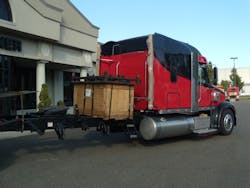Those making or using truck glider kits are being cautioned to reassess their plans following an about-face from previous guidance supplied by the Internal Revenue Service (IRS) regarding the tax rates for those products.
According to Bob Raybuck, director of technical services for the National Truck Equipment Association (NTEA), the IRS now suggests that the 75% rule when it comes to applying the 12% federal excise tax (FET) likely will not apply to many situations in which used components are combined with a glider kit to construct a tractor or truck.
“The most important thing fleets should take away from this right now is to stop what you’re doing and re-evaluate the tax consequences if you use glider kits,” he told Fleet Owner.
Raybuck pointed out that IRS changed its position on glider kits in its new 2014 Advice guidance, with the agency recommending that taxpayers should no longer follow the advice it previously provided in 2013.
The new 2014 Advice regarding the IRS’s tax position on glider kits considers four different scenarios, he explained, with the agency concluding that used or refurbished components were not articles (e.g., a chassis or tractor) that could be repaired or modified for purposes of the 75% Rule.
Instead, the IRS determined that taxpayer combining used or refurbished components with a glider kit had "manufactured a new article from a combination of new and used automotive components, none of which were articles.”
Therefore, the newly-manufactured article in each of the four scenarios is considered taxable, assuming the “completed article” exceeds the applicable taxable weight threshold, and in some cases the full 12% FET may apply as if the glider kit truck were a completely new vehicle.
“In those specific situations, it’ll be either fully taxable at the 12% rate or a significant amount of the FET may apply,” Raybuck cautioned. “By extension that means the prices for glider kits may need to change so as to account for the higher FET that’s applied.”
He cautioned, though, that the IRS’s 2014 Advice does not clarify the type or quantity of used components necessary to constitute an article for purposes of applying the 75% Rule, but the agency suggested that if there is not already an identifiable article (e.g., chassis or tractor) to which the glider kit is being added, the 75% Rule likely will not apply.
“This is not to say ‘stop using glider kits,’” Raybuck stressed. “For some fleets it may not be economically advantageous to worry about the tax consequences for in many instances time saved is as important as money saved. But we do suggest a ‘moment of pause’ to review the tax implications of this guidance.”
About the Author
Sean Kilcarr
Editor in Chief
Sean Kilcarr is a former longtime FleetOwner senior editor who wrote for the publication from 2000 to 2018. He served as editor-in-chief from 2017 to 2018.
